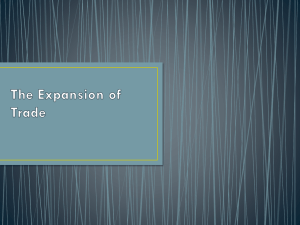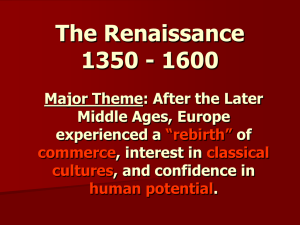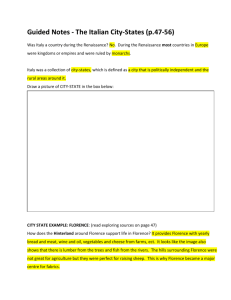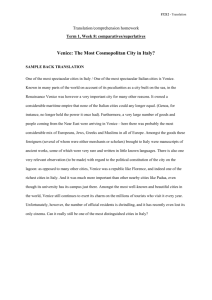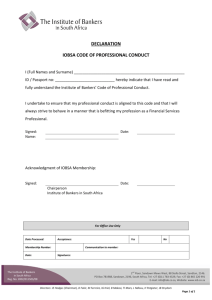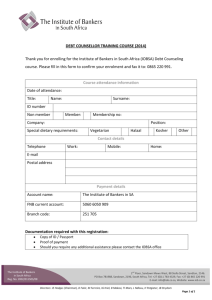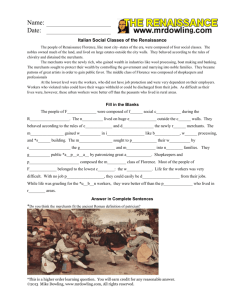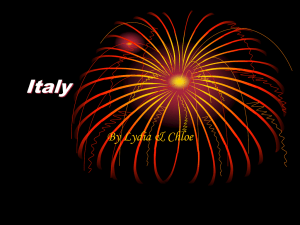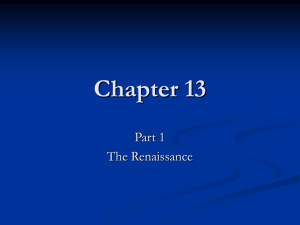What are the factors that led to the success of the Italian City States?
advertisement
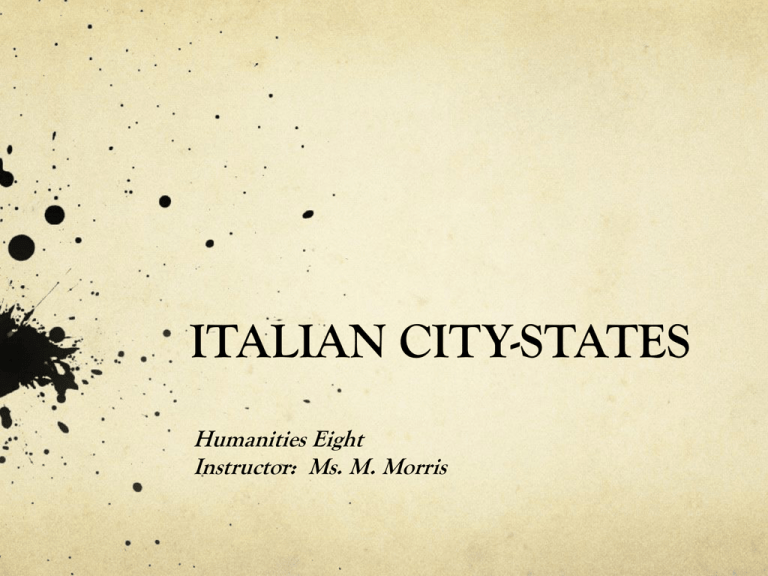
ITALIAN CITY-STATES Humanities Eight Instructor: Ms. M. Morris What is a city-state? at the time of Renaissance Europe the borders and boundaries were much different than they are today most countries were more like kingdoms, or principalities ruled by monarchs Italy was composed of different city states A city-state consisted of a city that was politically independent and the rural area around it The rural area was called the “hinterland” What are the factors that led to the success of the Italian City States? dozens of city-states grew across the northern half of Italy factors that led to the success of these city-states included: Factor #1 - Geography Italy was the closest to the port cities of northern Africa and the eastern Mediterranean Sea which allowed for the transportation of spices and other luxury items Because they were so close transporting these goods by sea made them cheaper than for those of other European countries Factor #2 - Climate it was milder in this part of Europe than those countries north of the Alps therefore trade was not interrupted due to winter weather they also had a longer growing season which produced crops like olives (pressed to make olive oil) and grapes(fermented to make wine) that were used in trade Factor #3 - Leadership in pre-modern Europe most countries were ruled by monarchies (kings and queens) while in Northern Italy there were independent city-states the city-states had their own governments, armies, and controlled their own affairs city-states like Venice, Milan, Florence and Genoa grew into the wealthiest trading, business and banking centres of Europe Factor #4 – Social Organization Feudalism did not have a strong hold in Northern Italy as it did in the rest of Europe when Feudalism ended, the nobles in these areas just moved into the cities and took their place in the upper classes of urban society they began businesses or entered into politics What did success look like in a powerful city-state? there was rivalry amongst all of the city-states as they wanted to expand their trade and their businesses example: Genoa and Venice competed for the control of the sea routes around the Mediterranean Example #1 - Venice when the city was first founded by the Roman as a group of islands in a protected harbor that was easily defended against invasion over a hundred years later it was a great trading centre with dealings with the East at the height of its power, Venetian merchants had thousands of ships travelling throughout the Mediterranean Sea and eventually along the Atlantic coasts to ports in Northern Europe The “Venice Arsenal” became the largest ship building centre in Europe employing two to three thousand workers Example #2 - Genoa controlled a share of trade in the eastern Mediterranean and also ports in the Black Sea in western Mediterranean it controlled trade with Spanish ports of Barcelona and Valencia Venice and Genoa were on equal footing with regards to power and trade until the Genoese fleet was destroyed in a naval battle with Venice in 1380 Genoa never regained its former power Assignment: Use the information provided on the sheets and answer the questions regarding Florence, Venice and about doing business. Refer to the next slide for a better look at figure 2-11 How did merchants make money? merchants made money by buying goods in one place and then selling them for a higher price in another place merchants dealt in spices, luxury items that were ready to be sold in the market place they also bought and sold resources such as wool for cloth How were workers protected? often workers belonged to a “guild” which helped to protect the rights of its workers, but in Florence a small group of workers known as the ciompi (wood carders) was not allowed to build a large guild by the government which was run by wealthy merchants; as a result they revolted and took over the government of Florence for awhile eventually the ciompi were defeated by the more powerful guilds How were bankers involved in commerce? bankers also brought money to the city-states Florentine bankers established banking houses across Europe The economy of Florence became so strong that the golden “florin” became the most important currency in Europe during the Renaissance Period How did bankers make money? These Florentine bankers created more wealth by charging interest when loaning money to someone, this was called Usury At first the church preached that ursury was sinful and should not be allowed Yet international trade required the large investment of money that would be tied up for years or had a good amount of risk to it so the Church began to allow the charging of interest (ursury) for these high risk loans (example: financing trading voyages were dangerous due to shipwreck and pirates) Over time bankers introduced new ideas to make trade and business easier between countries What does the artist suggest about the wife’s worldview by showing her turning away from the religious book in her hand to look at money? How were politics impacted by the desire for wealth? Politics was impacted by the city states wealth in that all social groups (nobles, bankers, shopkeepers, wealthy merchant families, small merchants, and craftspeople) all anted power Merchants and bankers disliked constant war or struggles as it interfered with making money, therefore they supported strong political leaders who promised stability and peace Florence competed with other city-states in banking Italian and European bankers travelled around Europe on business which exposed Europeans to the Italian ideals and lifestyle Also wealthy travelers from Europe, as well as artists and scholars visited Italy and were impressed by the cities and their sophistication; therefore when they returned to their home countries they took the Italian values and ideas with them What effect did money have on other parts of Italian culture? after the Black Death the economy in Italy went through a period of depression until the early 1500s bankers and merchants continued to grow in wealth through trade and commerce Comparing Worldviews with Regards to Wealth The Nuu-chah-nulth The Nuu-cah band consists of 15 separate but related First Nations whose traditional home is the western coast of Vancouver Island Here is how Chief Maquinna described their “banks”: Chief Maquinna Once I was in Victoria, and I saw a very large house. They told me it was a bank and that the white men place their money there…and that by and by they get it back with interest. We are Indians and we have no such bank; but when we have plenty of money or blankets, we give them away to other chiefs…and our hearts feel good. Our way of giving is our bank. Discuss: Turn to your group and discuss this question. What does Chief Maquinna’s quotation reveal about the Nuuchah-nulth worldview? How did wealthy people invest their money? this economic inequality with the merchants still making money but others not being as prosperous caused an increase in investment in art and culture there was very little for the wealthy to spent their money and wealth on therefore they began to buy art they also helped to beautify the cities and this encouraged feelings of loyalty and pride in the general public for their city-state Who were the Medici Family? Read the article about the Medici Family and answer the questions. Wealth and Responsibility Read the paragraphs on Wealth and Responsibility and answer the questions using complete sentences. Remember to apply your ideas to the Worldview Icon to ensure understanding.
